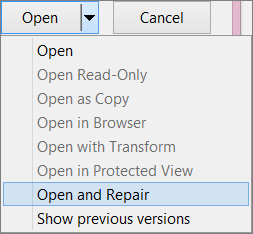File is corrupt вирус

Dec 17,2019 • Filed to: Recover & Repair Files • Proven solutions
Computer viruses cause different kinds of issues for different kinds of data present on our computers. In case you get attacked by a virus, there is a good chance that your MS Office files might get damaged or corrupted in some way. As a result when you try to open your MS Office files, you might come across some kind of error messages that prevent your files from getting opened. These error messages include the following as the most common ones:
- Microsoft Excel experienced an error while trying to open this file
- There was a problem encountered while sending the command to the program
- Your Normal.dotm file is corrupt or damaged and you have to replace it
While it seems to be really frustrating, it’s still not the end of the world since you can easily repair damaged Office files by making use of a file repair tool.
Part 1: The Best File Repair Tool for MS Office File
If you are looking to repair damaged Office files, you can either make use of the conventional techniques of data recovery or you can make use of a file repair tool to do that. The latter option has proved to be more effective in this regard. There are several file repair tools available in the market to help people repair MS Office files but Stellar File Repair Toolkit is the best one among the rest. It may be referred to as a computer software that is developed to work on MS Office files repair and restoration. Unlike the other tool kits available in the market, Stellar File Repair Tool kit not only offers better results but its features are also matchless. A few notable features in this regard are listed below.
The Best File Repair Toolkit
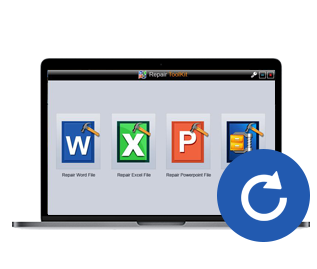
- Allows you to repair four different types of files namely, Word, Excel, PowerPoint and Zip.
- Extremely easy to use and is designed in such a manner that anyone can use it to repair corrupted files.
- Offers a number of excellent search options to find corrupted files in an instant.
- Provides an extraordinary preview feature that allows you to see the contents of the file to be repaired.
- Capable of recovering the all of the data contained in the corrupted file.
Note: Please close all MS Office file windows before you get start to repairing process
Part 2: Repair MS Office Files Damaged by Virus
The following simple steps to help you repair Office file damaged by virus:
Step 1 Launch File Repair Toolkit, ans select "Repair Word File" option.
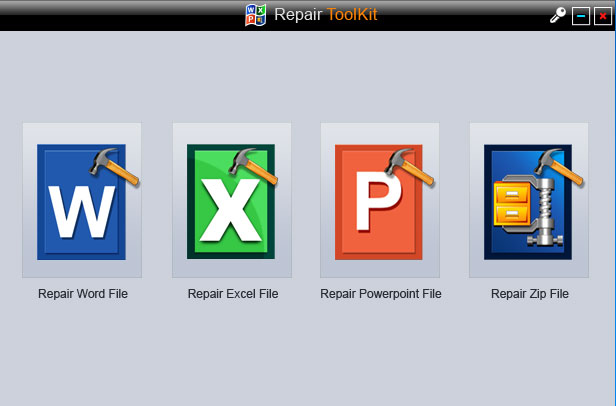
Step 2 Add damaged word files to search from drive.
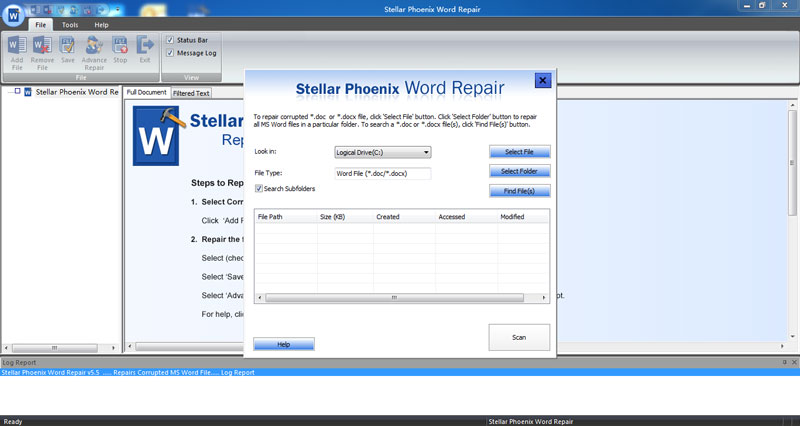
Step 3 All damaged Word files dispaly in the result section, chooes one to scan for repair.
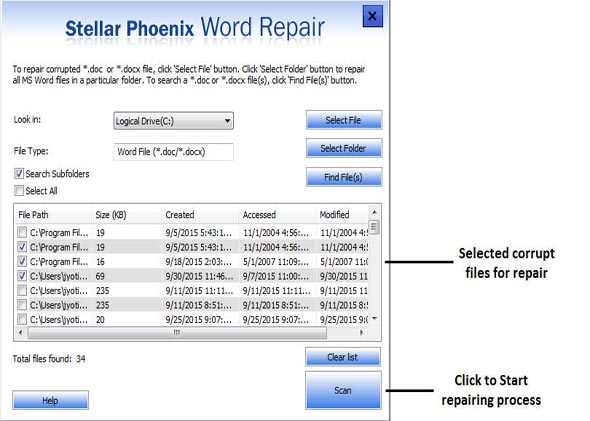
Step 4 Preview the repaired Word file and save it to a local drive.
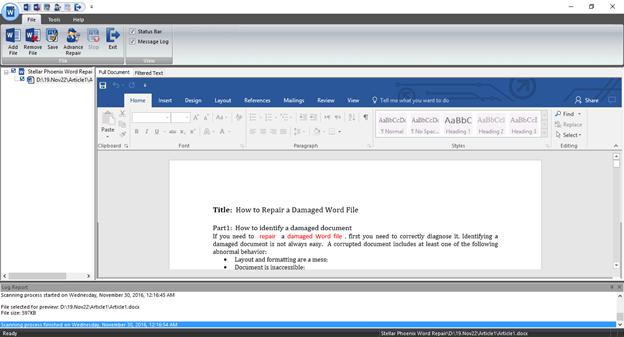
Part 3: The Other File Repair Options
In addition to the Stellar File Repair toolkit, there are a few other software applications that are known to deliver good results. A few of them are discussed below.
Stellar Excel Repair tool comes in very handy when you are looking to repair corrupted MS Excel files. The results delivered by this application are simply off the charts. A few notable features offered by Stellar Excel repair tool are listed below.
- Recovers all kind of data stored in damaged excel file such as tables, charts, formulas, comments, images, etc.
- Restore all of your corrupted excel files to their original standing.
- Preview the repaired excel file in real-time,see how much of the file has been recovered as it is being repaired.
- All kind of MS office corruption errors (for XLS and XLSX files only) can be handled with this tool.
- This excel file repair tool can be used on both windows and Mac platforms in order to repair corrupt excel file.
- All kind of MS office corruption errors (for XLS and XLSX files only) can be handled with this tool.
- This excel file repair tool can repair damaged Office files of all versions from 2000 to 2016 that includes 2000, 2003, 2007, 2010, 2013, etc.
Losing some important Power Point data can be really frustrating but you can be intelligent about it and get it all recovered using a file repair tool like Stellar PowerPoint repair tool. A few features offered by this tool are listed below:
- Repairs almost all cases of PPT file corruption by following a reliable and risk-free approach to PowerPoint recovery
- Repairs PowerPoint macro-enabled (.pptm) file and restore all PowerPoint objects with macros attachments
- Repair and restores any number of PPT/PPTX/PPTM files at the same time
- Perform a signature-based recovery of PPT files to recover your crucial data
- Repairs your corrupt PPT file and shows preview of all slides in the presentation before saving it at a user-specified location
Compressing several files into a ZIP not only allows us to save hard drive space but it also makes our data securer. File Repair Toolkit of Repair ZIP File option is designed to repair and restore ZIP files that might have gotten damaged as a result of different unavoidable issues. Some prominent features offered by this useful tool are listed below:
- Repairs ZIP files with any level of corruption
- Offers support for ZIP files having size as large as 800 MBs
- Offers recovery for ZIPs that are not protected with passwords
- Saves all the recovered data in the form of a compressed file
- Offers compatibility with Windows NT, 2000, XP, 2003, Vista, 7, 8 and 10
As discussed above, losing any important MS Office documents to corruption as a result of infestation by a computer virus turns out to be a really irritating experience. So it is best to make sure that you never have to face such a scenario ever again. A few tips that might come in handy in order to prevent such kind of situation in the future are listed below for your convenience.
- Install a good antivirus application in your computer and keep updating it on a regular basis so that it stays up to date with the latest viruses
- Always perform a proper shut down on your computer while you want to turn it off
- Keep more than one copies of your data in different locations on your hard drive to make sure you never lose any data to bad sectors

Dec 12,2019 • Filed to: Photo/Video/Audio Solutions • Proven solutions
Nowadays, videos have become part of most people’s lives. Many people are always shooting videos about memorable moments in their lives. But, it can be frustrating when you realize that these videos files are no longer playing on your device. Unfortunately, this situation appears to be happening often. This article will show you if viruses can affect your MP4s and what you can do to repair infected MP4 videos.
Part 1: Can MP4 Files Have a Virus?
There is a lot you need to be aware of to understand what might go wrong with your MP4 video files. In case you might be asking yourself, can mp4 have a virus? Sadly, viruses in your device can corrupt or damage your video files.
If your video binds to a virus, you are bound to see the extension or you can check in properties to find out its video format. Some viruses are in fake video files. When you attempt to play videos in your Windows Media Player, the device will search for the codec. Instead, of using the right codec, the video redirects it to the virus. Therefore, Windows would use the virus as codec, leading to infection of your MP4 video files.
MP4 files usually store Videos and music files. This video format is considered to be of high quality and it’s compatible with most devices. Besides, the format is convenient for sharing videos on social media platforms such as Facebook and Twitter. MP4 videos have file extension like .m4a, .mp4, .m4p, and .m4r. so, can mp4s have viruses? Simply put, yes because these extensions are vulnerable to virus infection. You might be wondering how this can happen. You see, it’s likely that malware can disguise itself as a video file, making the video files favorite for malware writers.
Part 2: How to Repair Damaged Videos Due to Virus Attack
Turns out that viruses in your computer or any other device can cause problems to your video files within a few minutes. This happens when you leave these devices unprotected. In such situations, it’s essential to repair damaged video files so that you can play them again. One of the best software to repair damaged videos is probably Recoverit Video Repair. This do-it-yourself software is a flexible video repair tool you can trust to recover your corrupt videos. Apart from repairing MP4 video format, it also restores other video formats such as MOV, MKV, M2TS, MTS, AVI, 3GP, and FLV.
Recoverit Video Repair is the software you need when you need to restore corrupt video files due to virus attacks. It has the Quick Repair mode to repair various video errors. Even better, if your video is severely damaged or corrupted, you can use its Advanced Repair mode. This mode allows you to repair your video by adding a Sample File.
With the ease of accessibility, it can support various video corruption situations. These include video file header corruption, video file system corruption, corruption on the video slider, corruption on the video frame, and many other corruption scenarios.
Recoverit Video Repair is considered as the most reliable video repair tool, and it quickly recovers both large-sized and high-resolution MP4 video files. To repair your damaged or corrupted video due to a virus, you can take the following steps:
Step 1: Run the Recoverit Video Repair Tool on your Computer
To begin with, download and install Recoverit Video Repair on your computer. Then launch the recovery software to begin the process of recovery. Add the corrupted video files for the recovery process.
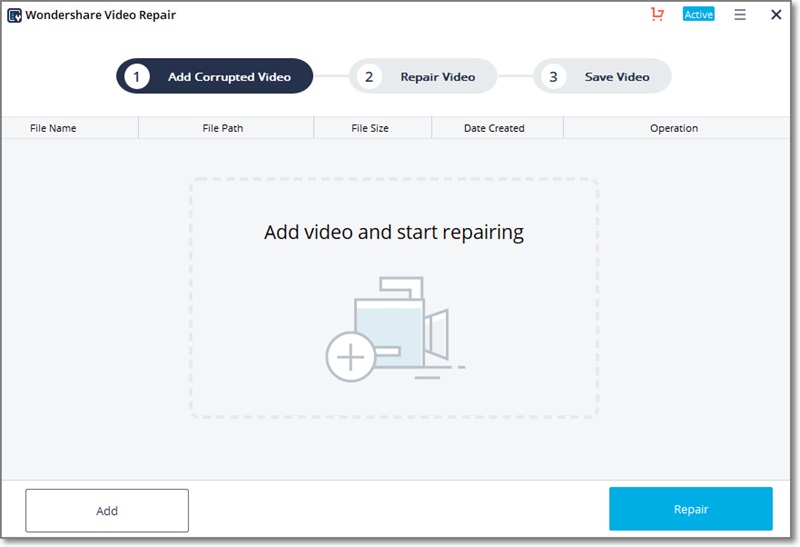
Step 2: The scanning process
Click "Repair" button to start the process of repairing corrupted video files. The Recoverit Video Repair will first use the Quick Repair mode to scan and repair the video files.
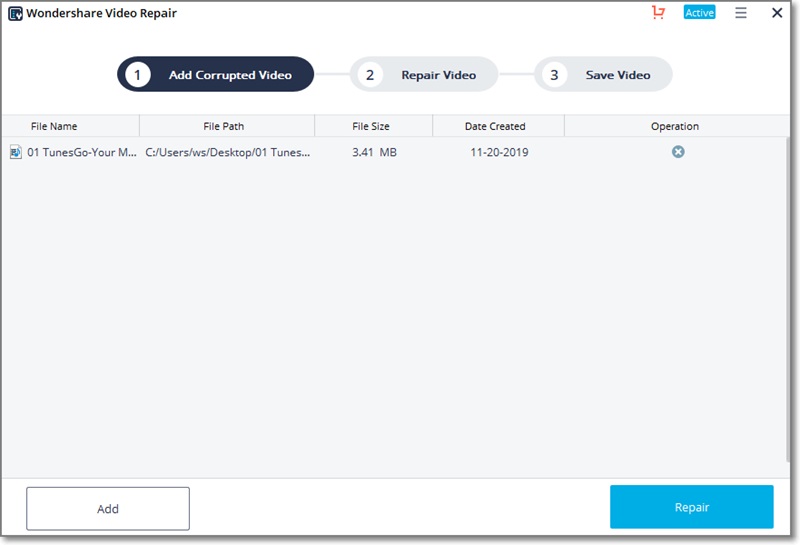
Step 3: Preview and Save
Once the repairing process is complete, you will see the recovered video files. Next, you can preview the MP4 videos to find out if the repairing process has been done to your satisfaction.
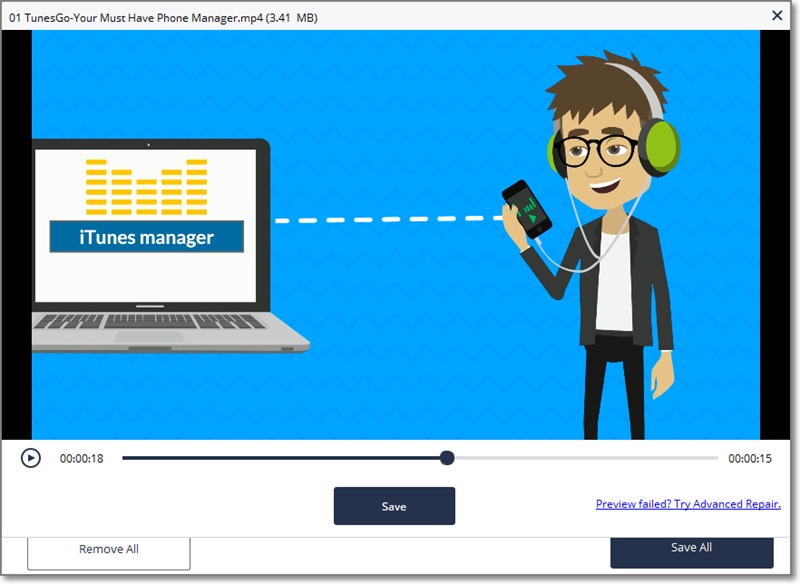
If that’s the case, you can save the recovered videos to any destination of your choice.
Step 4: Add the Sample Video files
If your video files are severely damaged, consider using the Advanced Repair mode. Just click "Advanced Repair" button to enter this mode. A Sample File is needed because Advanced Repair mode uses it to analyze the data and technology before repairing the damaged video. click the folder button to browse and select a simple file.
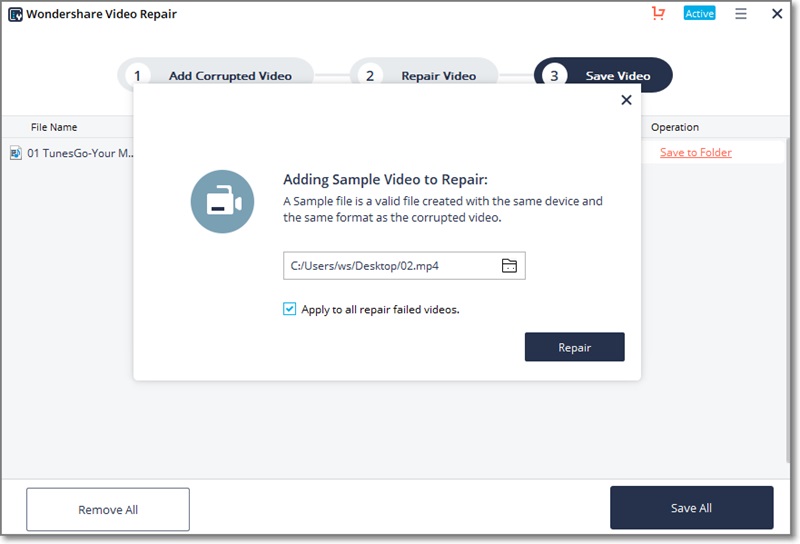
Step 5: The repairing process
Click "Repair" button, Recoverit Video Repair will start repairing the severely corrupted video files.
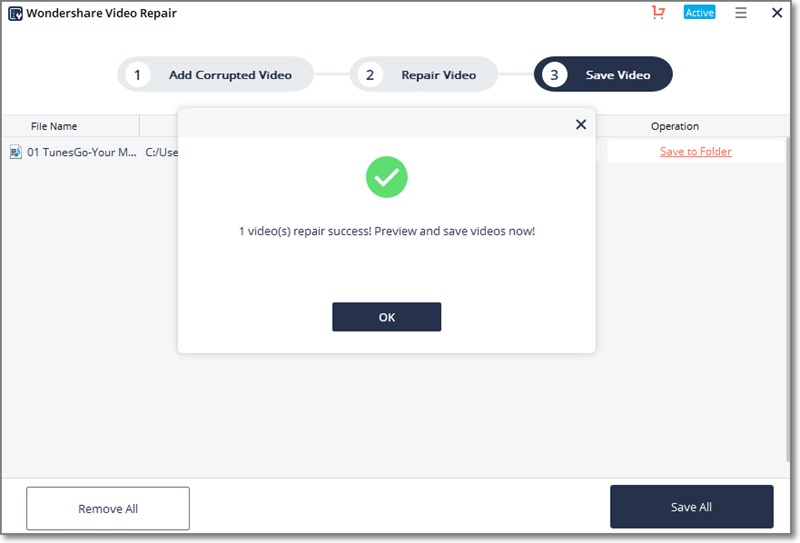
After completion, you can preview the recovered MP4 videos. You can also save the videos after the repairing process is done.
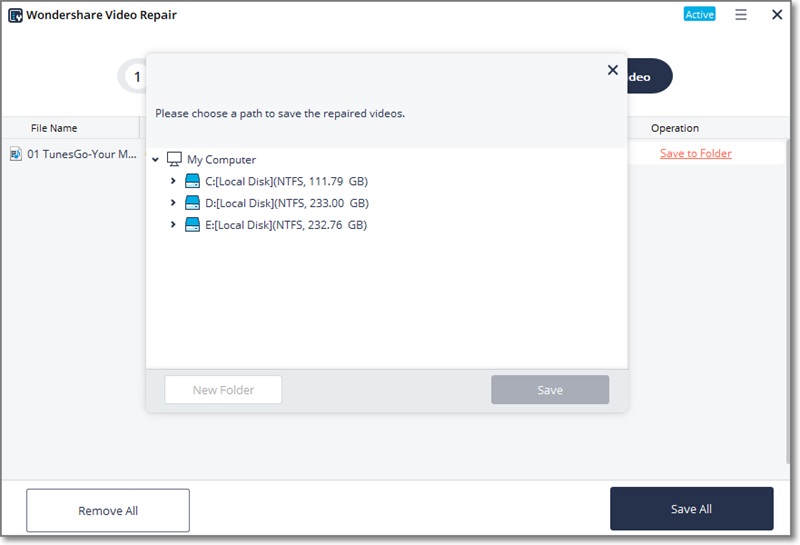
Best of all about using the Recoverit Video Repair is that it can repair video files from various devices, like SD card, memory card, computer hard drive, digital cameras, action cameras, etc. Because if has no limitations on the size of video files for repair, you can utilize the tool to repair any number of corrupt video files.
Part 3: How to Scan a Video for Virus
When a video file with a virus plays on your video player, the virus hangs and makes a connection to the host. This means hackers have access to your system when you connect to the internet. The good news is that you can know if a video file has a virus. It’s important to be aware of the video file types that hackers usually use.
You can check if the video files that are not playing have modified dates. In the same vein, make sure that you take precautions when downloading video files. This is because hackers sometimes cleverly sneak in viruses. For example, you might be tempted to download a video file with a .mp4.exe. The bad news is that this file might appear like a normal MP4 video file but the genuine files have a suffix that looks like .EXE.
To scan a video for a virus, it’s important to follow the recommended solutions. These solutions were created to remove viruses from your device either manually or automatically. You can start with the manual method but if it doesn’t work, consider using the automatic option which utilizes advanced anti-malware software. It’s only by doing this that you can scan a video file for viruses. If you desire to recover corrupted video files, then alternative tools such as the Recoverit Video Repair will help you get all damaged or corrupted videos.
Part 4: How to Prevent Video from Virus Infection
While you can remove viruses before they can cause more damage to your video files, it’s always recommended to devise ways to prevent videos from virus infection in the first place. Besides having an antivirus program, you can keep your computer safe by updating its software. With Windows update and updater for third-party programs, you are assured of having the perfect security system.
- Be careful of YouTube Video descriptions. When you don’t find YouTube videos, there is sometimes a link in the video description. Here’s the deal, such links usually lead you to fake sites that have a fake video file. Once you sign up to download the video, you are likely going to end up with some sort of malware.
- Malicious Ads. It’s not only the search for YouTube videos that would land you into trouble. Another threat comes in the form of ads especially if you have an out-of-date Microsoft browser. Despite YouTube having policies preventing ads from redirecting you to malicious sites, malicious links keep on coming up.
- Be wary of Tubrosa. To put it simply, you cannot get Tubrosa which is a form of malware on YouTube. However, YouTube video creators desire to make a decent living by creating videos that attract many viewers. For that reason, they use a shortcut to get a loyal audience by creating Tubrosa. This malware can infect your device, resulting in your device watching YouTube videos without you noticing it.
- Stay safe. You can prevent your videos from the virus if don’t click ads and links that offer something for free. Also, ensure that your children only use YouTube videos for schools. Such sites block everything that doesn’t seem educational.
The question can mp4 files contain viruses shouldn’t be tricky for you any longer. The above ways will not only help you prevent your video files from viruses, but they will also assist you to repair damaged or corrupted MP4 videos. Although manual methods are easy to use, the trusted Recoverit Video Repair is the only assured solution to repair infected MP4 videos.
How to Repair Virus Infected MS Word Files?
Virus can be a serious problem and can give nightmares to any computer user. A virus can enter your system by any medium and can infect important data in no time. Once a virus enters your system, nothing is safe anymore.
Like every other data, Microsoft Word files are also vulnerable to virus infection. Word files can behave strangely once infected. We are going to discuss how you can fix a virus-infected file using various methods.
There are many traps all over online and offline platforms from where your system can become virus infected.
- Downloading from a suspicious platform or website.
- Following suspicious or unknown links.
- Downloading an infected file or software.
- Running infected code as JavaScript in a web browser.
- Accepting any pop-up without reading it properly.
- Opening email attachments containing malicious codes.
- Connecting an infected disk or external drive.
- Weak security due to whatsoever reason.
- No antivirus in the system.
Recovering a virus-infected file is not an easy task, but if the right methods and techniques are used, one can make it a complete success. Let’s discuss those methods in detail.
Open and Repair is an inbuilt repair utility featured in MS Word with which you can cure recent corruption. This utility can only help with fixing recently damaged data or files, or minor corruptions. To work with this utility, follow the below-mentioned steps:
- Open MS Word and go to the Files option.
- Click on the Open option and then click on the Browse button.
- Now, select the file that you want to fix.
- Once you have selected the file, click on the Open drop-down below and select Open and Repair from there.
![]()
- After the process is done, your file will be fixed.
If this doesn’t solve your problem, then move to the next method.
Sometimes changing the file extension may help you fix the Word file issue. You might be moving mountains to repair that infected file, while all you needed was to change the file format. You can switch the file format to TXT or RTF format. To change the format, follow the below-mentioned steps:
- First, go to the file location. Right-click on the file and click Rename.
- Change the file extension to RTF or TXT.
- Now, open the changed file and move content to the new Word file.
- At this stage, save the Word file to a new location.
Doing this will fix your problem; if it doesn’t, then try the next method.
When nothing works for you, then maybe you need to switch to a better and guaranteed way to fix the problem. Kernel for Word Repair is one such tool that can fix a damaged, broken, or corrupt Word file in just a few easy steps. This tool is an automated approach to fix a problematic file. It doesn’t harm the original structure and hierarchy of the file.
-
First, go to the website and download Word Repair tool, then install and run it successfully on your system.


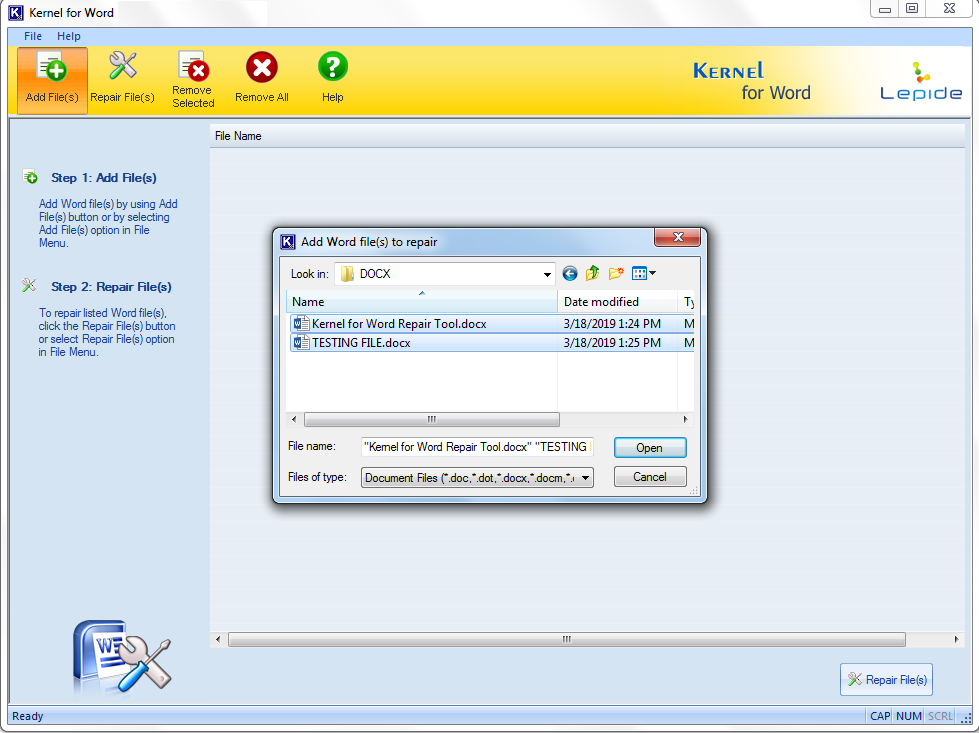
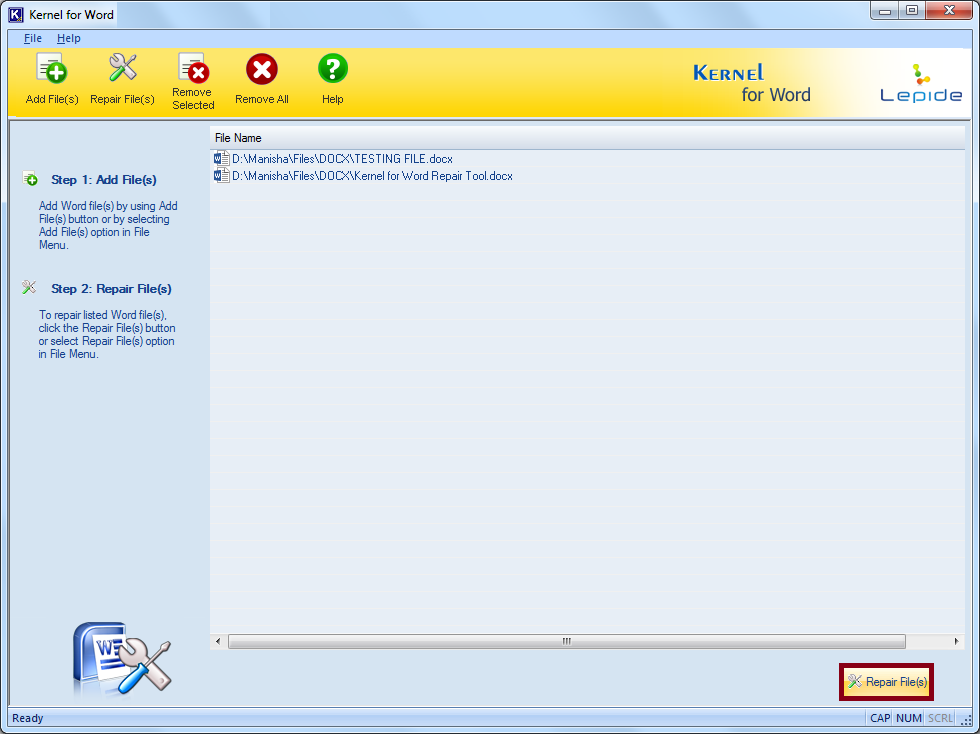
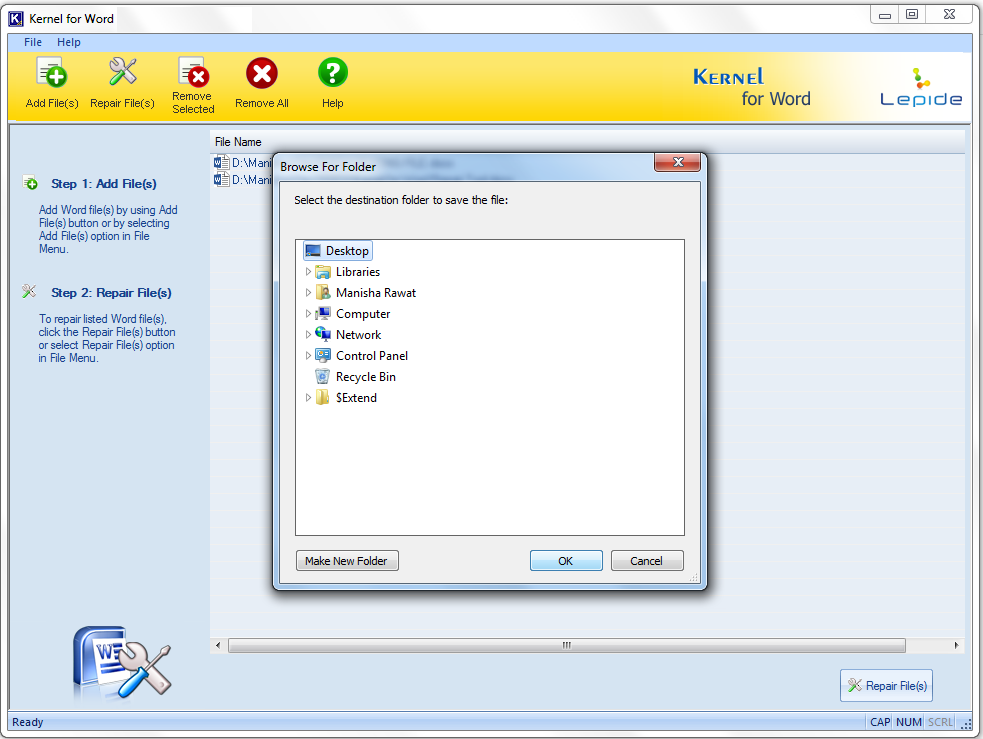
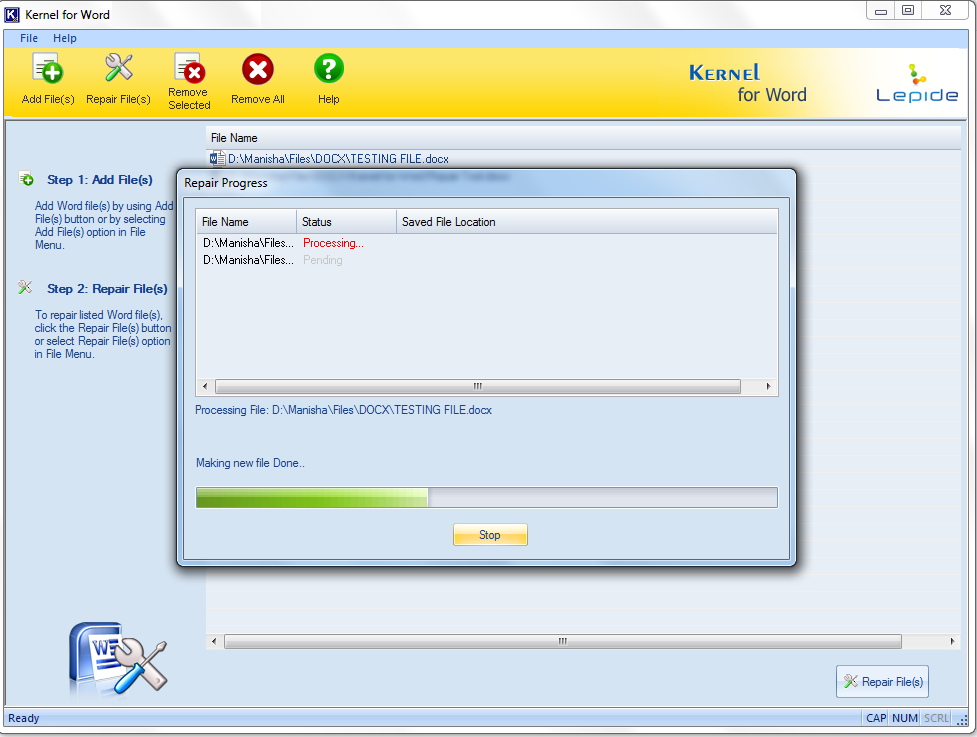
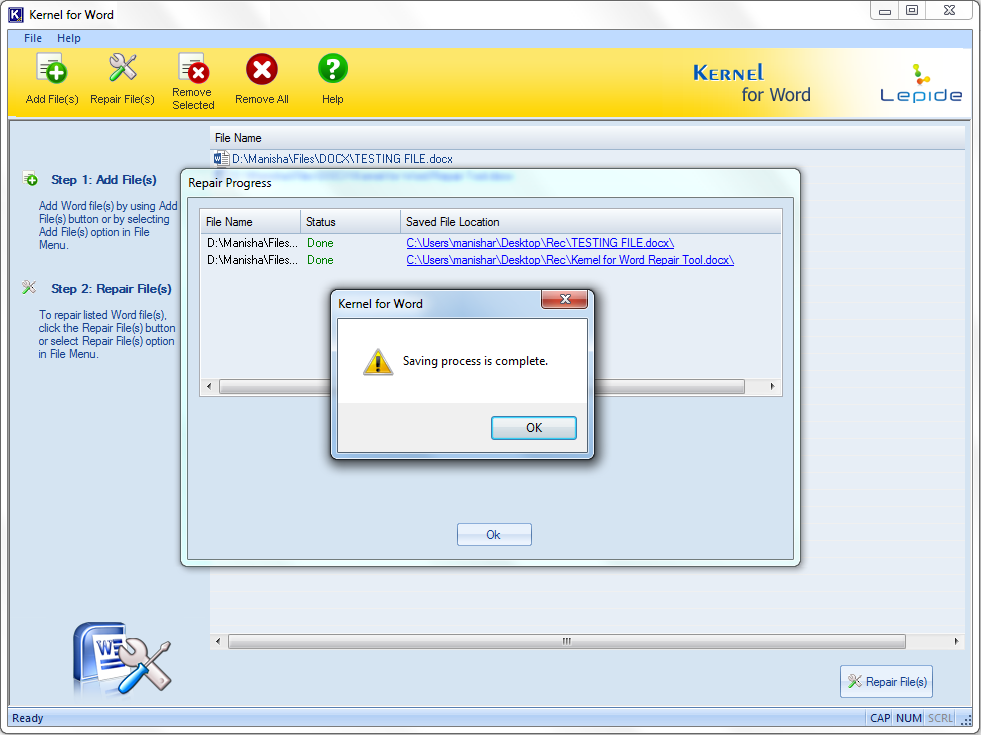
This is how you can fix a virus-infected file with Kernel for Word.

Virus infection of Word files is a common but serious issue and should be handled with the utmost care and professional attention. In this blog, we have discussed ways to fix virus infection with manual methods and as well as with Kernel for Word Repair. After performing all the methods, we found out that using an automated tool is the best way to achieve quick and desired results in case of virus Infection.
Understanding Hidden Threats: Corrupted Software Files
Malicious code is not always hidden in web page scripts or unusual file formats. Attackers may corrupt types of files that you would recognize and typically consider safe, so you should take precautions when opening files from other people.
An attacker may be able to insert malicious code into any file, including common file types that you would normally consider safe. These files may include documents created with word processing software, spreadsheets, or image files. After corrupting the file, an attacker may distribute it through email or post it to a website. Depending on the type of malicious code, you may infect your computer by just opening the file.
When corrupting files, attackers often take advantage of vulnerabilities that they discover in the software that is used to create or open the file. These vulnerabilities may allow attackers to insert and execute malicious scripts or code, and they are not always detected. Sometimes the vulnerability involves a combination of certain files (such as a particular piece of software running on a particular operating system) or only affects certain versions of a software program.
There are various types of malicious code, including viruses, worms, and Trojan horses (see Why is Cyber Security a Problem? for more information). However, the range of consequences varies even within these categories. The malicious code may be designed to perform one or more functions, including
- interfering with your computer's ability to process information by consuming memory or bandwidth (causing your computer to become significantly slower or even "freeze")
- installing, altering, or deleting files on your computer
- giving the attacker access to your computer
- using your computer to attack other computers (see Understanding Denial-of-Service Attacks for more information)
- Use and maintain anti-virus software - Anti-virus software can often recognize and protect your computer against most known viruses, so you may be able to detect and remove the virus before it can do any damage (see Understanding Anti-Virus Software for more information). Because attackers are continually writing new viruses, it is important to keep your definitions up to date.
- Use caution with email attachments - Do not open email attachments that you were not expecting, especially if they are from people you do not know. If you decide to open an email attachment, scan it for viruses first (see Using Caution with Email Attachments for more information). Not only is it possible for attackers to "spoof" the source of an email message, but your legitimate contacts may unknowingly send you an infected file. If your email program automatically downloads and opens attachments, check your settings to see if you can disable this feature.
- Be wary of downloadable files on websites - Avoid downloading files from sites that you do not trust. If you are getting the files from a supposedly secure site, look for a website certificate (see Understanding Web Site Certificates for more information). If you do download a file from a website, consider saving it to your computer and manually scanning it for viruses before opening it.
- Keep software up to date - Install software patches so that attackers cannot take advantage of known problems or vulnerabilities (see Understanding Patches for more information). Many operating systems offer automatic updates. If this option is available, you should enable it.
- Take advantage of security settings - Check the security settings of your email client and your web browser (see Evaluating Your Web Browser's Security Settings for more information). Apply the highest level of security available that still gives you the functionality you need.
This product is provided subject to this Notification and this Privacy & Use policy.
Understanding Hidden Threats: Corrupted Software Files
Malicious code is not always hidden in web page scripts or unusual file formats. Attackers may corrupt types of files that you would recognize and typically consider safe, so you should take precautions when opening files from other people.
An attacker may be able to insert malicious code into any file, including common file types that you would normally consider safe. These files may include documents created with word processing software, spreadsheets, or image files. After corrupting the file, an attacker may distribute it through email or post it to a website. Depending on the type of malicious code, you may infect your computer by just opening the file.
When corrupting files, attackers often take advantage of vulnerabilities that they discover in the software that is used to create or open the file. These vulnerabilities may allow attackers to insert and execute malicious scripts or code, and they are not always detected. Sometimes the vulnerability involves a combination of certain files (such as a particular piece of software running on a particular operating system) or only affects certain versions of a software program.
There are various types of malicious code, including viruses, worms, and Trojan horses (see Why is Cyber Security a Problem? for more information). However, the range of consequences varies even within these categories. The malicious code may be designed to perform one or more functions, including
- interfering with your computer's ability to process information by consuming memory or bandwidth (causing your computer to become significantly slower or even "freeze")
- installing, altering, or deleting files on your computer
- giving the attacker access to your computer
- using your computer to attack other computers (see Understanding Denial-of-Service Attacks for more information)
- Use and maintain anti-virus software - Anti-virus software can often recognize and protect your computer against most known viruses, so you may be able to detect and remove the virus before it can do any damage (see Understanding Anti-Virus Software for more information). Because attackers are continually writing new viruses, it is important to keep your definitions up to date.
- Use caution with email attachments - Do not open email attachments that you were not expecting, especially if they are from people you do not know. If you decide to open an email attachment, scan it for viruses first (see Using Caution with Email Attachments for more information). Not only is it possible for attackers to "spoof" the source of an email message, but your legitimate contacts may unknowingly send you an infected file. If your email program automatically downloads and opens attachments, check your settings to see if you can disable this feature.
- Be wary of downloadable files on websites - Avoid downloading files from sites that you do not trust. If you are getting the files from a supposedly secure site, look for a website certificate (see Understanding Web Site Certificates for more information). If you do download a file from a website, consider saving it to your computer and manually scanning it for viruses before opening it.
- Keep software up to date - Install software patches so that attackers cannot take advantage of known problems or vulnerabilities (see Understanding Patches for more information). Many operating systems offer automatic updates. If this option is available, you should enable it.
- Take advantage of security settings - Check the security settings of your email client and your web browser (see Evaluating Your Web Browser's Security Settings for more information). Apply the highest level of security available that still gives you the functionality you need.
This product is provided subject to this Notification and this Privacy & Use policy.
Читайте также:


